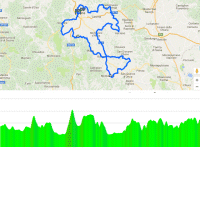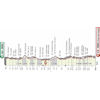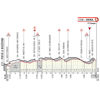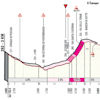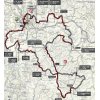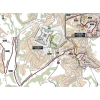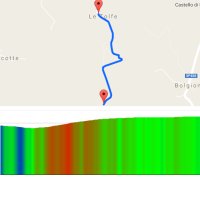Strade Bianche is one of the most photogenetic races on the calendar. Riders get on their bikes and leave the ancient town of Siena to enter a ride with medieval characteristics. In the rolling landscape of Tuscany the toughest sections are on twisting gravel paths. Last year’s race was played out in pouring rain and winner Tiesj Benoot crossed the line wearing a yellow-brownish mud mask. Weather forecastst for this edition are good though.
Sector 1 comes after 17.1 kilometres, 2.1 kilometres and perfectly straight, but offering a solid way to get warmed up to the hardships ahead. The day’s first climb coincides with the second sector. It’s 5.8 kilometres on gravel and the steepest ramps are 10%. Following two flat to descending stretches of dirt road – respectively 4.4 and 5.5 kilometres – the Strade Bianche tackles its second climb. This one is on tarmac and leads to the fortified town of Montalcino. The distance is 4 kilometres and the average gradient sits at 5%.
After the downhill the route continues to Lucignano d’Asso, which is – at 11.9 kilometres – the longest sector with fields and forest left and right. Just 1 kilometre of tarmac before sector 6 brings something extra to the mix. At 8 kilometres, it’s a ‘sterrato’ on winding roads, including both climbing and descending.
Some 11 kilometres of flat tarmac brings the riders to the next dust road. At 9.5 kilometers and mostly uphill, this one will weary the legs still further. It goes up and down in the first part and ends with a twisting climb before meeting the tarmac again.
At kilometre 130 the endgame begins with the presence of the Monte Sante Marie climb. Sector 8 amounts to 11.5 kilometres and is arguably the toughest of all sterrati at the Strade Bianche. It runs mostly uphill, although the strip also features some tricky descents. A good spot to attack, Valverde tried his luck last year, but he was countered by Romain Bardet and Wout Van Aert, who pushed on together.
Sector 8 continues onto 20 kilometres of smooth asphalt. Which may sound better than it actually is, as the route is either going up or down, while heading to the last three stretches of unpaved roads. Sector 9 is 800 metres and pepped up with a double digit gradient ramp before hitting the tarmac in Vico d’Arbia.
Last year, Tiesj Benoot bridged across to the leading duo just before the penultimate sterrato. Strade di Colle Pinzuto is the dust stretch which amounts to 2.4 kilometres and the steepest ramp is located at the beginning. But no time for a breather after the 15% ramp, as the road rises gradually all the way until the end.
The final gravel road is a 1.1 kilometres toil, opening with a short descent and closing with 18% gradients. When Strade Bianche reaches Le Tolfe all sterrati are history with still 12 kilometres to go. If any escapees are adrift, the winding roads of Tuscany favour them, as chasers will have difficulty pinpointing the attackers.
With 5 kilometres to go the road flies downhill, only to go back up again in the last kilometre. Entering the city walls of Siena, a 16% sector welcomes the riders. Then a sharp turn to the right, left, and right again. The finish is at Il Campo, Siena’s iconic square that looks a bit like a theatre.
Other interesting reads: results and start list of the 2019 Strade Bianche.
Strade Bianche 2019: route, profiles, more
Click on the images to zoom
